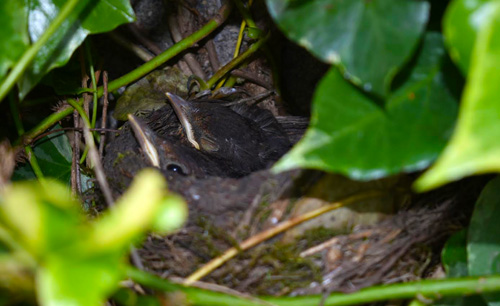“Sing a song of sixpence”
Sing a song of sixpence, a pocket full of rye.
Four and twenty blackbirds baked in a pie.
When the pie was opened, the birds began to sing,
Wasn’t that a dainty dish to set before the king?
The king was in his counting house, counting out his money.
The queen was in the parlour, eating bread and honey.
The maid was in the garden, hanging out the clothes,
When down came a blackbird and pecked off her nose.
There was such a commotion, that little Jenny wren,
Flew down into the garden, and put it back again.
END
The common Blackbird, formerly also known as an ‘Ouzel’, is a species of the Thrush family.
The plumage of the adult male is all black, except for a yellow beak.
The adult female and all juveniles birds, on the other hand, have mainly a dark brown plumage, with speckles on the upper breast, which slightly resemble our Irish Song Thrush.

Under the Irish Wildlife Act, it is against the law to cut, burn or otherwise destroy vegetation including hedges between March 1st and August 31st. The purpose of this ban is to prevent the disturbance and destruction of nesting sites of many of our wild bird species.
Pic: G. Willoughby.
One would have assumed that Carrion Crows, Ravens, Rooks and Jackdaws would have been referred to first as ‘blackbirds’, but of course historically the word ‘bird’ was correctly used to differentiate larger species from the smaller bird variety; hence the larger Crows, Jackdaws etc. are categorised as ‘wild fowl’.
The blackbird species breeds in Irish woods and gardens; building a neat, round cup-shaped nest, same bound together with dried muck.
Its daily diet includes a wide range of insects, earthworms, berries, and fruits. It is a regular visitor to our bird tables, attracted by porridge oats, fruit and cooked potato leftovers. The birds are territorial, especially during the breeding season.
The English nursery rhyme above, entitled ‘Sing a Song of Sixpence’ is possibly as old as the 1500s; which we all learned as primary school kids, was supposedly a coded message used by the legendary pirate Captain Blackbeard to recruit pirates. Sixpence and a hip-flask of rye whisky was the weekly pirate’s wage. Thus the ‘blackbirds’ were Blackbeard’s pirates and the ‘pie’ his sailing vessel.
Yet another theory, which is more acceptable, suggests that the King ‘in his counting house’ and the ‘Queen in the parlour’, actually refers to Catherine of Aragon, the first wife of Henry VIII, while the maid ‘in the garden, hanging out the clothes’, refers to Ann Boleyn, second wife of Henry VIII.
Henry VIII, our readers will remember, divorced and executed Ann Boleyn, whom he had beheaded on May 19th, 1536, at the Tower of London.
So the reference to the blackbird snipping off the maids nose could possibly represent his decision to separate from the then existing Church of Rome.

LOVELY SONGS